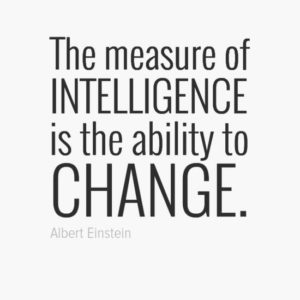According to Harvard Business Review the failure rate of major change initiatives in organizations is 70%.
Albert Einstein said, the measure of intelligence is the ability to change. And we know from Darwin that “It is not the strongest of the species that survives, nor the most intelligent that survives. It is the one that is most adaptable to change.”
We are all familiar with IQ and EQ, but developing our Change Intelligence, as explained by Barbara A. Trautlein (called “CQ”), may be the best way to for us to increase the success of change initiatives.
Psychologically, change equals pain. Organizational change provokes discomfort. The brain sends out powerful messages that something is wrong, which causes our limbic system (think “fight or flight”) to kick in and diminishes our capacity for higher thought.
We have all heard that change will happen when the pain of staying the same is greater than the pain of change. We know that positive change requires a commitment from senior management, a “guiding coalition,” and a “compelling vision.” See our previous post about Harvard’s John Kotter and his model for leading change.
Change is a process that moves people from a focus on the past to a focus on the future. Change also causes people (whether they know it or not) to shift their focus from what’s happening in the organization, to what’s happening inside themselves. According to Trautlein’s book, Change Intelligence, the stages of change closely parallel those of grief. When we first learn of an impending change, we go into denial. Next comes resistance, or at least what looks and feels like resistance to change leaders. If the resistance is effectively managed, we move to the exploration stage, testing the new direction. Finally, commitment occurs.
Change intelligence means recognizing the different change leadership styles and learning how to apply them:
- People (emotional or “heart”)
- Purpose (cognitive or “head”)
- Process (behavioral or “hands”)
Each of these is important and by integrating these three aspects of change we can greatly improve the success rate change initiatives. What if we begin to use the principles of CQ within our associations as we implement business analytics? We can change the statistics of change initiatives!




